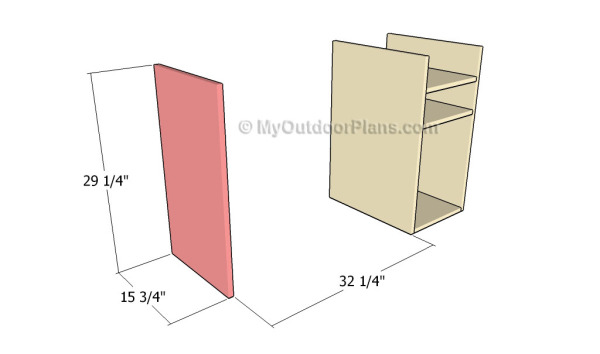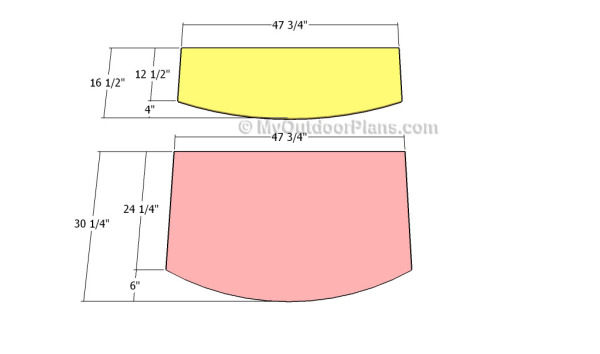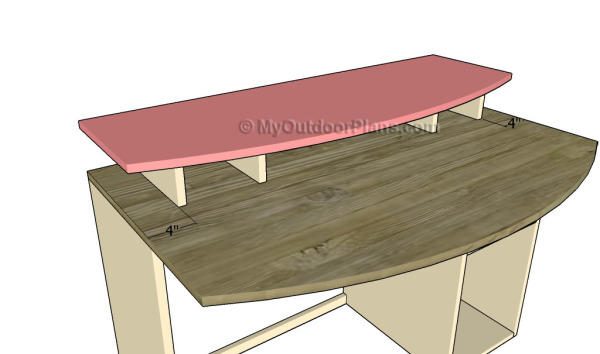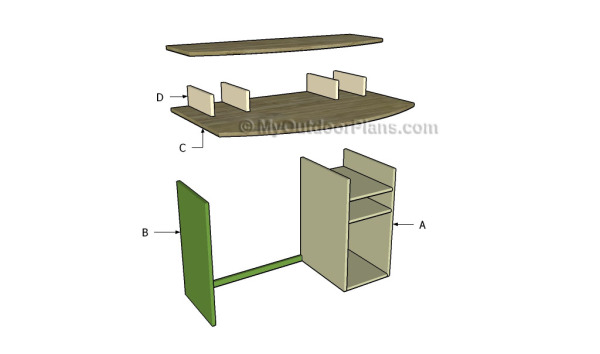This step by step diy woodworking project is about computer desk plans. If you want to learn more about building a desk for your computer, pay attention to the following instructions. Work with good judgement and don’t forget to take a look over the rest of the related plans, as there are many designs and woodworking projects to select from.
Work with attention and don’t forget that a good planning will save you from many issues and it will keep the costs withing the total budget. Invest in high quality materials, such as pine, redwood or cedar. Drill pocket holes before inserting the galvanized screws, to prevent the wood from splitting. Add waterproof glue to the joints, in order to enhance the rigidity of the structure. See all my Premium Plans HERE.
Projects made from these plans
Computer Desk Plans
Cut & Shopping Lists
- A – 2 pieces of 3/4″ plywood – 19 3/4″x29 1/4″ long, 3 pieces – 13″x19 3/4″ long STORAGE UNIT
- B – 1 piece of 3/4″ plywood – 15 3/4″x29 1/4″ long, 1 piece of 1×2 lumber – 32 1/4″ long LEG
- C – 1 piece of 3/4″ plywood – 16 1/2″x48″ long, 1 piece – 30 1/4″x48″ long TABLETOPS
- D – 4 piece of 3/4″ plywood – 12″x4 1/4″ long SUPPORTS
- 1 piece of 3/4″ plywood – 4’x8′
- 1 piece of 1×2 lumber – 3 ft
- 2 1/2″ screws
- 1 1/4″ screws
- wood putty, wood stain
Tools
![]() Hammer, Tape measure, Framing square, Level
Hammer, Tape measure, Framing square, Level
![]() Miter saw, Drill machinery, Screwdriver, Sander
Miter saw, Drill machinery, Screwdriver, Sander
Time
![]() One day
One day
Building a computer desk

Building the storage unit
The first step of the woodworking project is to build the storage unit. As you can easily notice in the diagram, we recommend you to cut the components out of 3/4″ hardwood plywood. Take accurate measurements and cut the components at the right size.
Drill pocket holes along the side edges of the horizontal components, align the edges and insert 1 1/4″ screws to create rigid joints. Drill pocket holes along the top edges of the side components.

Building the side support
The next step of the indoor woodworking project is to build the side support for the computer desk. As you can easily notice in the diagram, we recommend you to cut the support out of 3/4″ plywood. Smooth the cut edges with fine-grit sandpaper and drill pocket holes along the top edge.

Building the tabletops
Continue the indoor project by cutting the two tabletops. In order to get a professional result, we recommend you to mark the cut lines using a pencil and to take accurate measurements.
Top Tip: Use a good circular saw to make the straight line cuts and a jigsaw to make the curved cuts. Smooth the cut edges with fine-grit sandpaper and remove the residues, before fitting them to the wooden supports.

Fitting the tabletop
Fitting the tabletop into place is a straight-forward process, but there are a few aspects you need to consider for a professional result. Therefore, we recommend you to align the top component at both ends and to make sure the edges are flush.
Check if the corners are square and insert 1 1/4″ screws through the sides into the top. In addition, fit a 1×2 support to the bottom of the computer desk. Drill pocket holes at both ends and insert 1 1/4″ screws into the frame.

Fitting the supports
Next, build the supports for the second tier tabletop, out of 3/4″ plywood. Drill pocket holes along the bottom and top edges and secure them into place using galvanized screws.

Fitting the supports
Center the top component to the supports and align the back edge properly. Make sure the edges are flush and add glue to the joints. If the space is too tight to insert 1 1/4″ pocket screws through the supports into the top, we recommend you to drill pilot holes and to insert the screws through the top into the supports.

Computer desk plans
One of the last steps of the woodworking project is to take care of the finishing touches. Therefore, fill the pilot holes with wood putty and smooth the surface with 120-grit sandpaper.
Top Tip: If you want to enhance the look of the woodworking project and to protect the desk from decay, we recommend you to cover the components with paint or stain. Fit appropriate hinges and door handles to the cabinet.
This woodworking project was about computer desk plans. If you want to see more outdoor plans, we recommend you to check out the rest of our step by step projects. LIKE us on Facebook and Google + to be the first that gets out latest projects and to hep us keep adding free woodworking plans for you.

